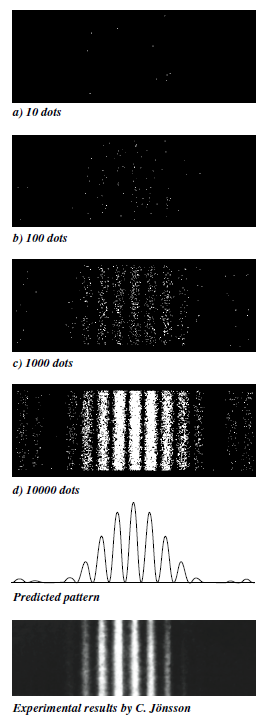
Born’s Interpretation of the Particle Wave
 المؤلف:
E. R. Huggins
المؤلف:
E. R. Huggins
 المصدر:
Physics 2000
المصدر:
Physics 2000
 الجزء والصفحة:
963
الجزء والصفحة:
963
 1-1-2021
1-1-2021
 2525
2525
Born’s Interpretation of the Particle Wave
In 1926, while calculating the scattering of electron waves, Max Born discovered an interpretation of the electron wave that we still use today. In Born’s picture, the electron is actually a particle, but it is the electron wave that governs the behavior of the particle. The electron wave is a probability wave governing the probability of where you will find the electron.
To apply Born’s interpretation to the two slit electron experiment, we do what Campbell did in the simulation of Figure (1). We first calculate what the wave pattern at the screen would be for a wave passing through the two slits. It is the two slit interference pattern we have seen for water waves, light waves and electron waves. We then interpret the intensity of the pattern at some point on the screen as being proportional to the probability that the electron will land at that point. We cannot predict where any given electron will actually land, any more than we can predict where the ball will end up on the roulette wheel. But we can predict what the pattern will look like after many electrons have landed. If we repeat the experiment, the electrons will not land in the same places, but eventually the same two slit pattern will result.

Figure 1: Computer simulation of the 2 slit electron diffraction experiment, as if the electrons had landed one at a time.
 الاكثر قراءة في مواضيع عامة في الفيزياء النووية
الاكثر قراءة في مواضيع عامة في الفيزياء النووية
 اخر الاخبار
اخر الاخبار
اخبار العتبة العباسية المقدسة


